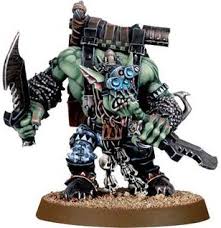In part 4 of this series, I will cover two more principles of building an effective Kill Point Denial list. Part 1 of this series introduced the concept and definitions including the key point that Kill Point Denial relies heavily on the Multiple Objective Mission format. The second article discussed the reasons why Kill Point Denial has great advantages in these style missions. The third article introduce the first principle of Kill Point Denial, using and identifying units that are "tough" and won't give up kill points.
Positive Kill Point Potential
Not giving up Kill Points by utilizing some tough units is only part of the process. To win at Kill Points, you still have to have a way to claim your own. When you combine a list's potential to not give up kill points plus claim some, you need to have a strong positive kill point potential. This is a more or less subjective measure on a list's ability to pick up some kill points while not giving any up. This is subjective because it varies from match-up to match-up, based on dice rolls, and a whole lot of other factors. (What does't in 40k?)
Increasing your Positive Kill Point Potential
One good way to do this is to include units which are very good at taking down light armor. Since the 5th ed. paradigm is to run heavy transport lists and since transports are generally "not tough" (see article 3), they give up easy kill points. Thus, one way to pick up easy kill points would be to specifically target these style vehicles with your list. The concept is you snipe out a few easy transport kills which ups your kill points while not giving away any and gain a substantial kill point lead. At that point, you are free to focus on other objectives or just running away for the win.
 Another good way to pick up some easy kill points is designed around units which can take down small, 5 man squads with solid anti-infantry fire. Again, this is abusing the MSU paradigm. Since you know that a lot of your opponents will be utilizing small squads in their lists, design some anti-infantry shooting around taking them out easily. This is basically the same concept as aiming for easy to kill transports but just aiming for troops instead.
Another good way to pick up some easy kill points is designed around units which can take down small, 5 man squads with solid anti-infantry fire. Again, this is abusing the MSU paradigm. Since you know that a lot of your opponents will be utilizing small squads in their lists, design some anti-infantry shooting around taking them out easily. This is basically the same concept as aiming for easy to kill transports but just aiming for troops instead.
GENERALLY, aiming for transports is the smarter option because this will deny your opponent mobility which is tactically good for avoiding assaults as well as competing for another objective in the mission.
 Foot units like 10 man devastator squads are both tough due to squad size as well as add a lot of positive kill point potential in their ability to take down light armor. It's very easy for 4 lascannons, for example, to kill a Rhino, netting a quick KP. The enemy has to dump a lot of fire into devastators to take them out, and when things get scary, they just pack up and run for terrain. ALL OF THAT creates a positive kill point potential.
Foot units like 10 man devastator squads are both tough due to squad size as well as add a lot of positive kill point potential in their ability to take down light armor. It's very easy for 4 lascannons, for example, to kill a Rhino, netting a quick KP. The enemy has to dump a lot of fire into devastators to take them out, and when things get scary, they just pack up and run for terrain. ALL OF THAT creates a positive kill point potential.
Second Objective Plan
A solid KP Denial list should find winning at Kill Points to be extremely trivial through a combination of list and tactics. However, to really be successful with a KP Denial list, I have found that you absolutely need to include a plan for how you will score a 2nd objective in a multiple objective mission.
The reason for this is that this gives you options to win the game rather than just tie. Overall, then, this increases the tactical flexibility of your entire game plan.
Second Objectives change from tournament to tournament. How will you know what you need to do? Read the tournament primer and make a decision. Here are a few tips.
 Speed units are a great way to contest and/or control objectives. This generally includes unit which can turbo-boost, move flat out, or are "tar pit" style units with 18-24 inch charge ranges. These units excel at doing things like contesting your opponent Cap&Control objective on the last turn to force him into a loss on that objective or simply contesting Seize Ground objectives to PREVENT your opponent from winning on that objective. Basically, units which can quickly re-deploy elsewhere on the battlefield while also using their speed to make them "tough" to avoid assaults and shooting with terrain.
Speed units are a great way to contest and/or control objectives. This generally includes unit which can turbo-boost, move flat out, or are "tar pit" style units with 18-24 inch charge ranges. These units excel at doing things like contesting your opponent Cap&Control objective on the last turn to force him into a loss on that objective or simply contesting Seize Ground objectives to PREVENT your opponent from winning on that objective. Basically, units which can quickly re-deploy elsewhere on the battlefield while also using their speed to make them "tough" to avoid assaults and shooting with terrain.
(KEY POINT: Always remember that in multiple objectives, the game is not just to claim objectives but you can also win by denying your opponent the ability to get objectives)
 Outflanking, back field, and reserve manipulation units are also very good here. Again, this tends to focus on contesting objectives. Just be very careful that you aren't giving up easy kill points just to have an out-flanking unit. Also, Deep Striking works very well here.
Outflanking, back field, and reserve manipulation units are also very good here. Again, this tends to focus on contesting objectives. Just be very careful that you aren't giving up easy kill points just to have an out-flanking unit. Also, Deep Striking works very well here.
 A more advanced tactic is the tar pit unit, just in general. These are the types of units which can engage in a close combat that will essentially last the entire game. Thus, they don't give up kill points, but more importantly, they prevent enemy units from moving away from the combat. This has many benefits if deployed properly. The first is, if you can tar pit a unit on top of an objective, the objective will be contested for the rest of the game. Likewise, if you can tar pit key enemy units, you can prevent them from getting to any objectives on your side of the board to assaulting your units.
A more advanced tactic is the tar pit unit, just in general. These are the types of units which can engage in a close combat that will essentially last the entire game. Thus, they don't give up kill points, but more importantly, they prevent enemy units from moving away from the combat. This has many benefits if deployed properly. The first is, if you can tar pit a unit on top of an objective, the objective will be contested for the rest of the game. Likewise, if you can tar pit key enemy units, you can prevent them from getting to any objectives on your side of the board to assaulting your units.
The Short is, you need a plan
The key to the principle here is having a plan about how you will go about getting that 2nd objective. More importantly, it is having a plan above and beyond just winning the game on kill points.
No comments:
Post a Comment
Due to spam, all comments are moderated.
Pat
Note: Only a member of this blog may post a comment.